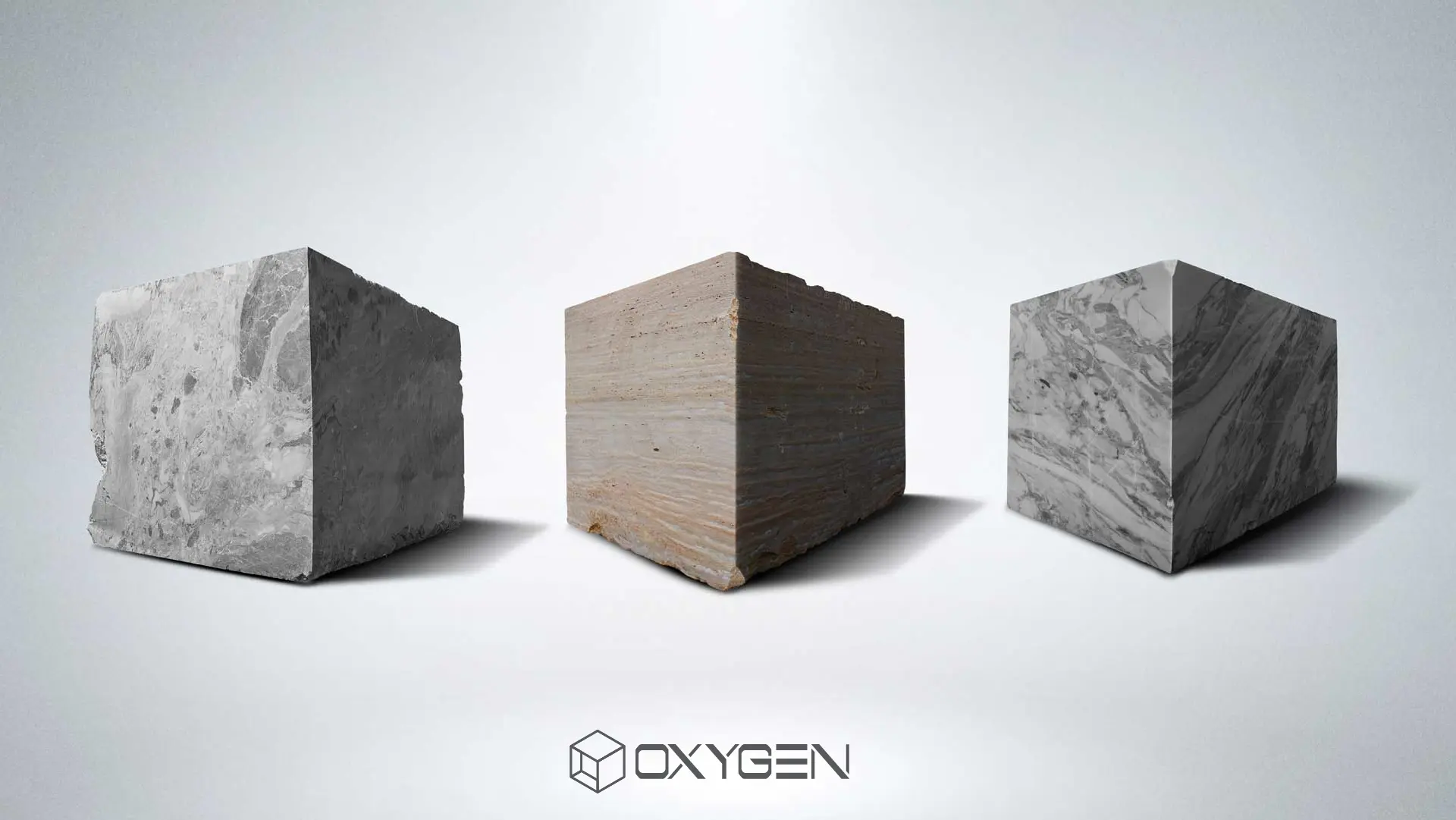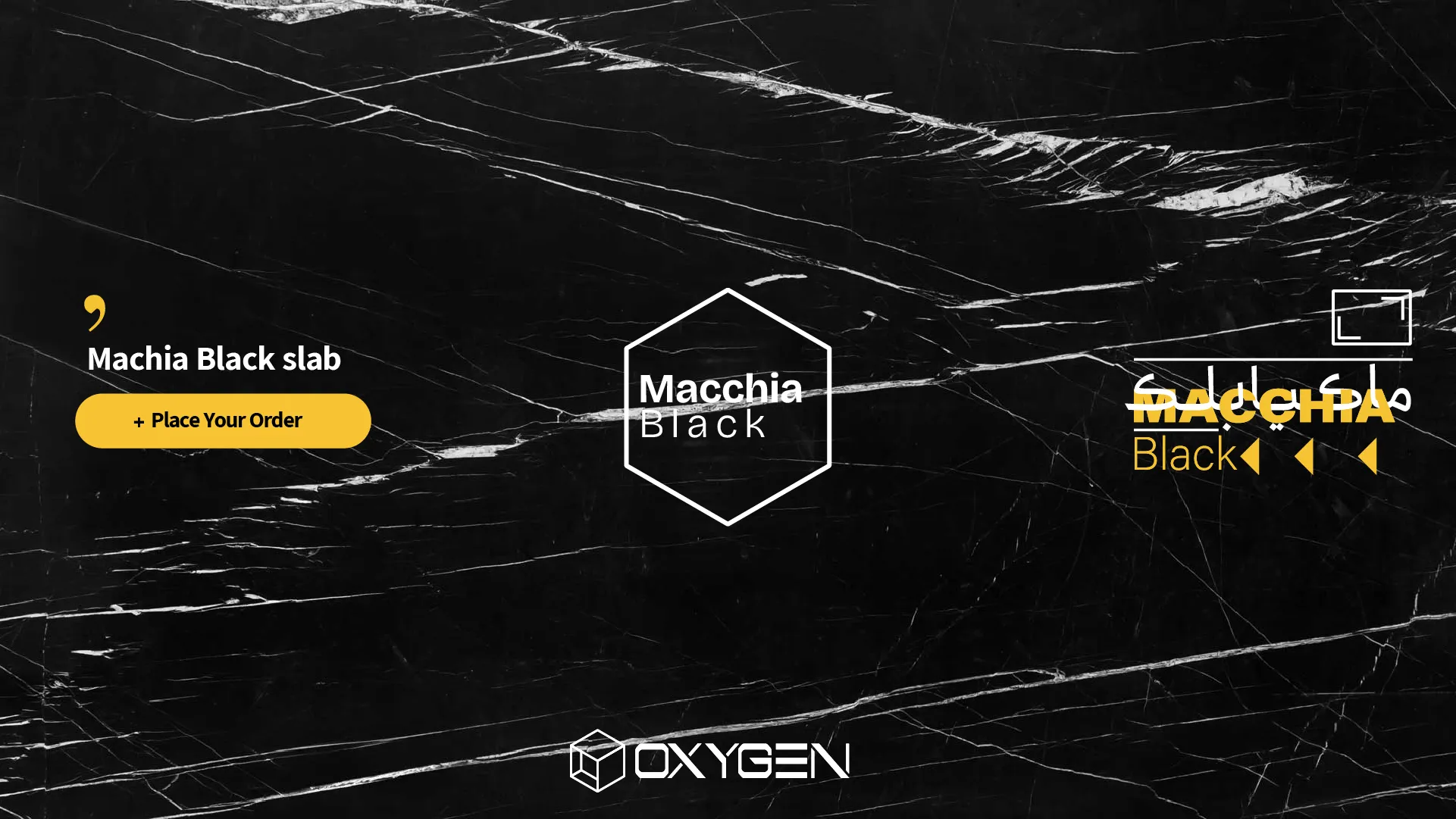
East Mahyar Marmarit
East Mahyar Marmarit is among the most distinguished and high-quality materials in the building stone industry. Characterized by a deep black background adorned with striking white and golden veins, it lends a distinctive and elegant aesthetic to various spaces. Owing to its exceptional properties, this stone is regarded as a preferred choice for both interior and exterior architectural designs. Oxygen Stone Company supplies premium marbles, including Macchia Gold and Macchia Black, sourced from the East Mahyar quarries, allowing customers to experience the perfect blend of beauty and durability. This article explores the features, applications, and advantages of East Mahyar Marmarit, highlighting its role in enhancing the aesthetics and structural quality of construction projects.
Introduction to Marble (Marmarit) Stones of East Mahyar
The Marmarit stones of East Mahyar are highly sought after for their deep black background, accentuated by irregular white and golden veins, making them a preferred choice among customers. The most striking visual characteristic, immediately capturing attention, is the contrast of the deep black background with its distinctive white and golden veins—an unparalleled and irreplaceable feature due to the stone’s natural formation. From a color psychology perspective, the interplay of black and gold conveys an aura of grandeur, and when placed in a bright, spacious setting, it enhances the aesthetic appeal with remarkable elegance. The stones extracted from this quarry include Macchia Black, Macchia Gold, a fusion of Macchia Gold and Black, as well as Sahara East stone.
Marmarit Quarry of East Mahyar
The Marmarit quarry of East Mahyar is situated in Isfahan Province, in the city of Shahreza, south of Isfahan. It is accessible via the Isfahan-Shahreza road, spanning a distance of 48 kilometers from Isfahan to the village of Mahyar. Additionally, its strategic location enables efficient access to the industrial stone hubs of Mahmoodabad, Rezvanshahr, and Najafabad, thereby reducing transportation costs to processing centers. Beyond its advantageous proximity to industrial zones, the quarry is distinguished by its meticulous sorting of extracted blocks, which are systematically stored in separate sections. With a reserve exceeding 50,000 tons, the site operates four active extraction faces from which blocks are continuously sourced.
Examination of Visual Features of East Mahyar Marmarit
The defining visual characteristic of the Marmarit stones from East Mahyar lies in their color and vein patterns. Before delving into these aesthetic attributes, it is important to highlight their visual resemblance to their Italian counterparts. The names Macchia Black and Macchia Gold, the most renowned stones from this quarry, are derived from the term "Macchia," which refers to a luxurious, high-grade marble quarried in Italy, particularly in the Macchia region of Umbria Province. Additionally, "Macchia" denotes the bright or golden veins frequently found in this type of stone, further contributing to its distinctive appeal.
- Color: The Marmarit stones from the East Mahyar quarry feature a uniform black background, setting them apart from Lashotor marble (Marmarit).
- Veins and Patterns: The veins in this stone are more widely spaced and less dense compared to Lashotor marble (Marmarit). However, the veins in East Mahyar Marmarit are slightly narrower than those in Lashotor marble, contributing to its distinct appearance. The vein colors in East Mahyar Marmarit include white, yellow, gray, and various combinations of these shades.
Examination of Physical Features of East Mahyar Marmarit
The physical properties of East Mahyar Marmarit offer advantages over other well-known marbles, such as Lashotor and Najafabad Black.
- Water Absorption Rate: The water absorption rate of East Mahyar Marmarit is remarkably low, approximately 0.14%, compared to 0.62% in Lashotor marble and 0.44% in Najafabad Black marble. Due to its minimal water absorption, this stone is well-suited for use in humid environments, including bathrooms and restrooms.
- Compressive Strength: The compressive strength of East Mahyar Marmarit is notably high, measuring approximately 119.5 megapascals. In comparison, Najafabad Black and Lashotor marbles have compressive strengths of 62 and 124 megapascals, respectively. This indicates that East Mahyar Marmarit exhibits significantly greater compressive strength than Najafabad Black marble and a strength level comparable to Lashotor marble.
- Abrasion Resistance: East Mahyar Marmarit demonstrates significantly higher abrasion resistance than Najafabad Black and Lashotor marbles, with a resistance of at least 21 megapascals, compared to 3 megapascals for both Najafabad Black and Lashotor marbles.
- Specific Weight: The specific weight of East Mahyar Marmarit is approximately 2.68 grams per cubic centimeter, which is slightly lower than that of Najafabad Black and Lashotor marbles (2.77 grams per cubic centimeter).
Applications of East Mahyar Marmarit
The beauty of East Mahyar Marmarit makes it a versatile choice for various applications, particularly in interior spaces. Macchia Black is commonly used for interior wall and floor cladding, kitchen countertops, bathrooms, and even staircases. To maximize its visual impact and functionality, several key factors should be considered when incorporating Macchia Black into a design. Installing this stone in well-lit and spacious areas enhances its elegance and distinct appearance. Furthermore, the veined slabs of East Mahyar Marmarit allow for stunning book-matching and form-matching designs.
Processing
Like other building stones, East Mahyar Marmarit Black is extracted from quarries in block form and transported to stone processing factories, where it undergoes various treatments and is cut into different dimensions, such as slabs and tiles. The processing of these stones requires specific precautions to prevent block breakage before cutting and to enhance their durability. These measures include reinforcing the stone with a mesh backing, filling pores with epoxy, and utilizing UV technology for waterproofing and to prevent chemical reactions between the veins and water. The finishing techniques applied to these stones include polished and honed processing.

Similar Stones to East Mahyar Marmarit
A brief review of the marbles available in the Iranian market indicates that Lashotor, Najafabad Black, and Golden Black Kashan marbles can be considered comparable to East Mahyar Marmarit. While these stones share certain similarities, they also differ in both visual characteristics and physical properties, some of which have been discussed in the section analyzing these features. Given these factors, East Mahyar Marmarit, with its distinctive visual appeal, offers significant advantages in critical physical aspects for architects and buyers, such as higher compressive and abrasion resistance, as well as lower water absorption compared to similar materials.
Conclusion
In conclusion, East Mahyar Marmarit has established itself as a distinguished option in the building stone industry, owing to its unique aesthetic and superior physical properties. This stone is an ideal choice for designers and builders, not only for its striking beauty but also for its exceptional strength and durability. Furthermore, the meticulous extraction and precise processing of this stone have enhanced its overall quality, ensuring customer satisfaction. By offering this premium product alongside its other high-quality marbles, Oxygen Stone Company contributes to the realization of construction projects that meet the highest standards. It is hoped that this article has provided valuable insights into East Mahyar Marmarit and has inspired informed decisions in architectural and construction design.
Words: 3
Characters: 20


